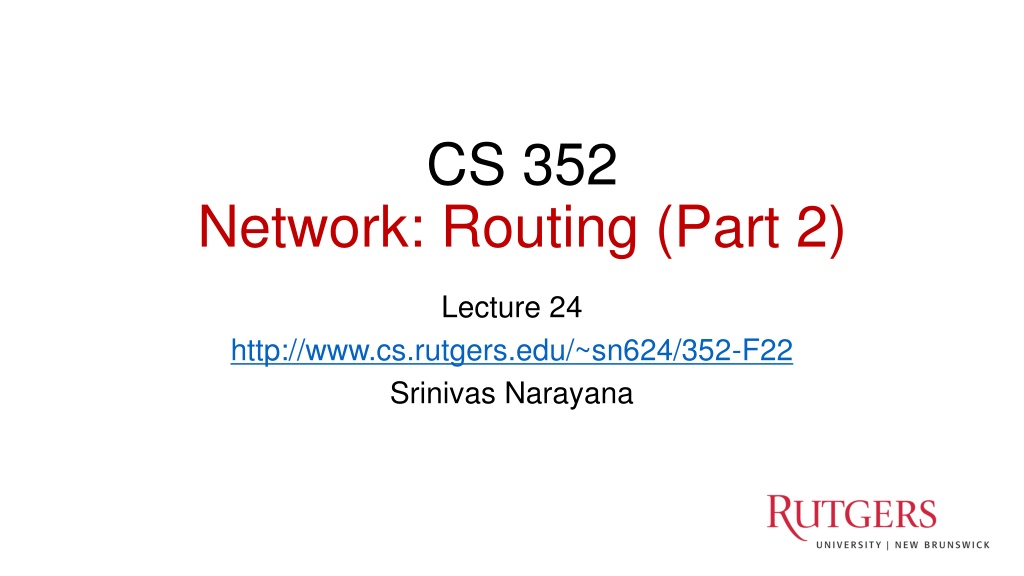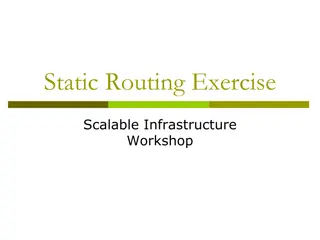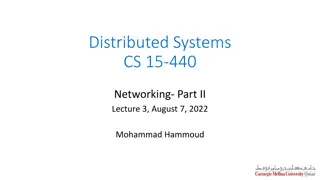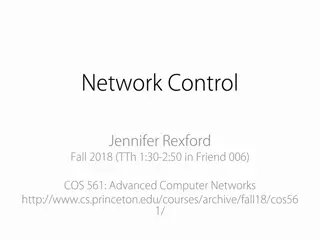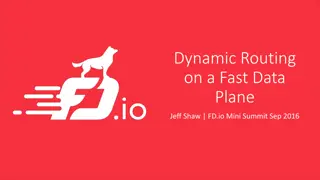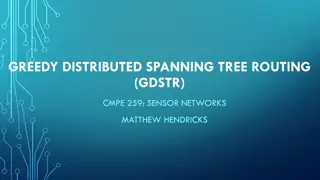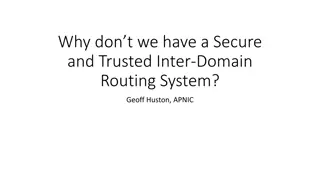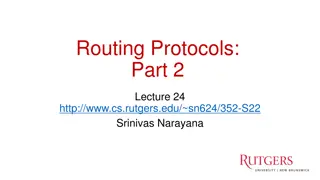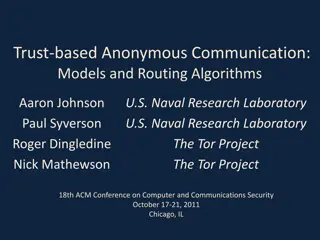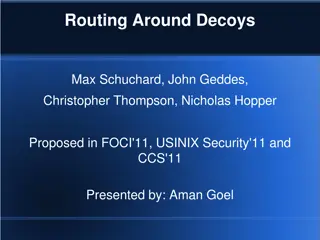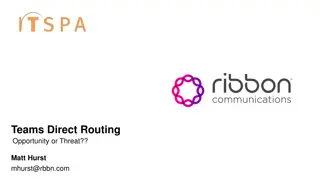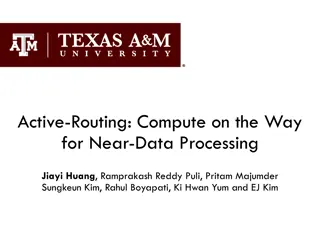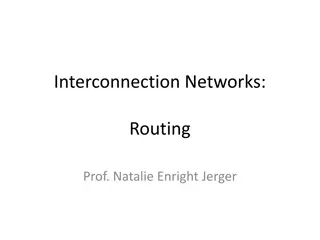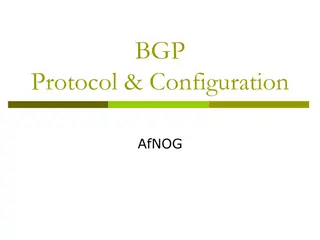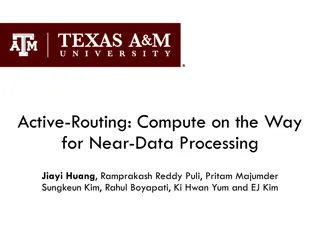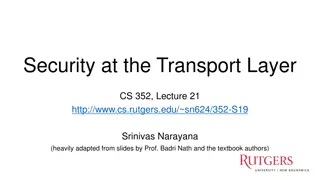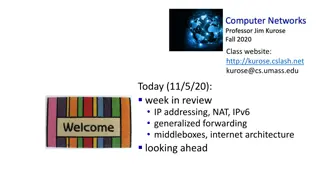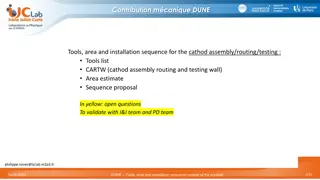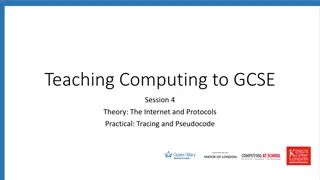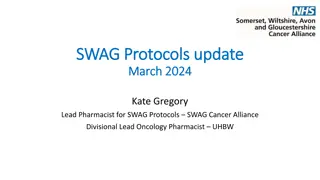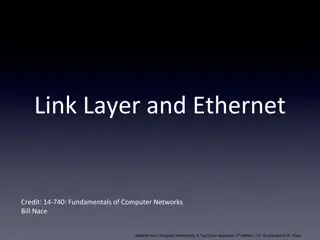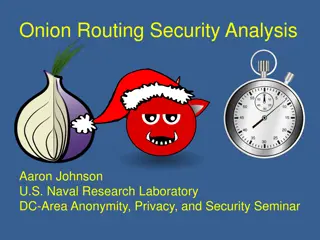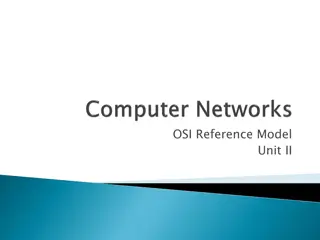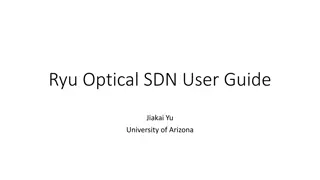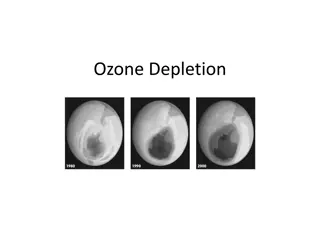Understanding Routing Protocols in Network Layer
Routing protocols in the network layer dictate how data packets are routed through a network. This lecture delves into key concepts such as reachability, routing protocol components, and the workings of Distance Vector (DV) algorithms. It explains how updates propagate in networks efficiently with DV protocols, highlighting the speed of good news and the challenges of bad news propagation. Further insights compare Link State and Distance Vector algorithms, outlining their characteristics and applications in routing. Overall, the content emphasizes the importance of efficient routing mechanisms for maintaining network connectivity and stability.
Download Presentation

Please find below an Image/Link to download the presentation.
The content on the website is provided AS IS for your information and personal use only. It may not be sold, licensed, or shared on other websites without obtaining consent from the author. Download presentation by click this link. If you encounter any issues during the download, it is possible that the publisher has removed the file from their server.
E N D
Presentation Transcript
CS 352 Network: Routing (Part 2) Lecture 24 http://www.cs.rutgers.edu/~sn624/352-F22 Srinivas Narayana 1
The network layer is all about reachability. Routing Protocol = Msg Exchange + Algorithm Graph abstraction Control plane Routing protocols Data plane Nodes Edges Weights Link state protocols Distance vector protocols Distance vector: Dx = [Dx(y): y N ] dx(y) = minv {c(x,v) + dv(y) } www.cs.princeton.edu
DV: Good news travels fast Suppose the link cost reduces or a new better path becomes available in a network. The immediate neighbors of the change detect the better path immediately Since their DV changed, these nodes notify their neighbors immediately. And those neighbors notify still more neighbors until the entire network knows to use the better path Good news travels fast through the network This is despite messages only being exchanged among neighbors 1 y 4 1 x z 2
DV: Bad news travels slowly If router goes down, could be a while before network realizes it. B still thinks it can reach A through C bad! A B C D E 1 2 3 4 Initially C thinks it can reach A through B worse! 3 2 3 4 After 1 exchange 3 4 3 4 After 2 exchanges B, D think they can reach A through C ugly! 5 4 5 4 After 3 exchanges Count to infinity problem 5 6 5 6 After 4 exchanges 7 6 7 6 After 5 exchanges etc to infinity
DV: Bad news travels slowly Reacting appropriately to bad news requires information that only other routers have. DV does not exchange sufficient info. A B C D E B needs to know that C has no other path to A other than via B. DV does not exchange paths; just distances! Poisoned reverse: if X gets its route to Y via Z, then X will announce dX(Y) = in its message to Z Effect: Z won t use X to route to Y However, this won t solve the problem in general (think why.)
Summary: Comparison of LS and DV Link State Algorithms Nodes have full visibility into the network s graph Copious message exchange: each LSA is flooded over the whole network Robust to network changes and failures OSPF Open Shortest Path First (v2 RFC 2328) Distance Vector Algorithms Only distances and neighbors are visible Sparse message exchange: DVs are exchanged among neighbors only Brittle to router failures. Incorrect info may propagate all over net EIGRP Enhanced Interior Gateway Routing Protocol (RFC 7868)
Routing protocols Link state protocols Distance vector protocols Every router is aware of the existence of every other router. Messages reveal information on the full network (graph) structure. Message exchange and forwarding tables scale with network size. These assumptions do not hold on the Internet.
The Internet is a large federated network AT&T Comcast Verizon
The Internet is a large federated network Several autonomously run organizations: No one boss Organizations cooperate, but also compete AT&T Comcast e.g., AT&T has little commercial interest in revealing its internal network structure to Verizon. Verizon
The Internet is a large federated network Several autonomously run organizations: No one boss Organizations cooperate, but also compete AT&T Message exchanges must not reveal internal network details. Comcast Verizon Algorithm must work with incomplete information about its neighbors internal topology.
The Internet is a large federated network Internet today: > 70,000 unique autonomous networks Internet routers: > 800,000 forwarding table entries AT&T Keep messages & tables as small as possible. Don t flood Comcast Verizon Algorithm must be incremental: don t recompute the whole table on every message exchanged.
Inter-domain Routing Routing approaches so far (LS + DV) are applicable within one autonomous system (AS), e.g., Rutgers Called intra-domain routing protocols The Internet uses Border Gateway Protocol (BGP) All AS es speak BGP. It is the glue that holds the Internet together BGP is a path vector protocol Routing protocols Link state protocols Path vector protocols Distance vector protocols Messages? Algorithm?
Loop detection is easy (no count to infinity ) Q1. BGP Messages Exchange paths: path vector Routing Announcements or Advertisements I am here or I can reach here Occur over a TCP connection (BGP session) between routers Route announcement = destination + attributes Destination: IP prefix Route Attributes: AS-level path Next hop Several others: origin, MED, community, etc. An AS promises to use advertised path to reach destination Only route changes are advertised after BGP session established No link metrics, distances! I am here. Dst: 128.1.2.0/24 AS path: X I can reach X Dst: 128.1.2.0/24 AS path: AS2, X AS 2 1b 2b 1a 1c 2a 2c X 1d 2d
Q1. Next Hop Next hop conceptually denotes the first router interface that begins the AS-level path The meaning of this attribute is context-dependent In an announcement arriving from a different AS (eBGP), next hop is the router in the next AS which sent the announcement Example: Next Hop of the eBGP announcement reaching 1c is 2a 2b 1b X 2a 2c 1a 1c 2d 1d eBGP announcement: AS2, X AS 2 AS 1
Q1. Next Hop Suppose router 1c imports the path (more on this soon) Router 1c will propagate the announcement inside the AS using iBGP The next hop of this (iBGP) announcement is set to 1c In particular, the next hop is an AS1 internal address 2b 1b X 2a 2c 1a 1c 2d 1d eBGP announcement: AS2, X AS 2 AS 1
Q2. The algorithm A BGP router does not consider every routing advertisement it receives by default to make routing decisions! An import policy determines whether a route is even considered a candidate Once imported, the router performs route selection A BGP router does not propagate its chosen path to a destination to all other AS es by default! An export policy determines whether a (chosen) path can be advertised to other AS es and routers Policy considerations make BGP very different from intra-domain (LS / DV) protocols Programmed by network operator
Policy arises from business relationships Customer-provider relationships: E.g., Rutgers is a customer of AT&T Peer-peer relationships: E.g., Verizon is a peer of AT&T Business relationships depend on where connectivity occurs Where , also called a point of presence (PoP) e.g., customers at one PoP but peers at another Internet-eXchange Points (IXPs) are large PoPs where ISPs come together to connect with each other (often for free)
BGP Export Policy legend: provider network B X W A customer network: C Y Suppose an ISP only wants to route traffic to/from its customer networks (does not want to carry transit traffic between other ISPs) A,B,C are provider networks X,W,Y are customers (of provider networks) X is dual-homed: attached to two networks policy to enforce: X does not want to route from B to C via X So, X will not announce to B a route to C
BGP Export Policy legend: provider network B X W A customer network: C Y Suppose an ISP only wants to route traffic to/from its customer networks (does not want to carry transit traffic between other ISPs) A announces path Aw to B and to C B will not announce BAw to C: B gets no revenue for routing CBAw, since none of C, A, w are B s customers C will route CAw (not using B) to get to w
BGP Import Policy legend: provider network B X W A customer network: C Y Suppose an ISP wants to minimize costs by avoiding routing through its providers when possible. Suppose C announces path Cy to x Further, y announces a direct path ( y ) to x Then x may choose not to import the path Cy to y since it has a peer path ( y ) towards y
Q2. BGP Route Selection When a router imports more than one route to a destination IP prefix, it selects route based on: 1. local preference value attribute (import policy decision -- set by network admin) 2. shortest AS-PATH 3. closest NEXT-HOP router 4. Several additional criteria: You can read up on the full, complex, list of criteria, e.g., at https://www.cisco.com/c/en/us/support/docs/ip/border-gateway- protocol-bgp/13753-25.html 23
Example of route selection EU NA Suppose AS A and B are connected to each other both in North America (NA) and in Europe (EU) A source in NA wants to reach a destination in EU There are two paths available Assume same local preference Same AS path length Closest next hop-router: choose path via B1 rather than B2 Dst-EU A1 A2 AS A B1 B2 Src-NA AS B
Example of route selection EU NA Choosing closest next-hop results in early exit routing Try to exit the local AS as early as possible Also called hot potato routing Reduce resource use within local AS potentially at the expense of another AS Dst-EU A1 A2 AS A B1 B2 Src-NA AS B
Computing the forwarding table AS3 3b AS1 1b 3a 3c 1a 1c AS2 2b X 3d 1d 2a 2c 2d Suppose a router in AS1 wants to forward a packet destined to external prefix X. How is the forwarding table entry for X at 1d computed? How is the forwarding table entry for X at 1c computed? 26
eBGP and iBGP announcements AS3 3b AS1 1b 3a 3c 1a 1c AS2 2b X 3d AS3,X 1d AS2,AS3,X 2a 2c 2d AS2 router 2c receives path announcement AS3,X (via eBGP) from AS3 router 3a Based on AS2 import policy, AS2 router 2c imports and selects path AS3,X, propagates (via iBGP) to all AS2 routers Based on AS2 export policy, AS2 router 2a announces (via eBGP) path AS2, AS3, X to AS1 router 1c 27
eBGP and iBGP announcements AS3 3b AS1 1b 3a 3c 1a 1c AS2 2b X 3d AS3,X 1d AS2,AS3,X 2a 2c 2d A given router may learn about multiple paths to destination: AS1 gateway router 1c learns path AS2,AS3,Xfrom 2a (next hop 2a) AS1 gateway router 1c learns path AS3,Xfrom 3a (next hop 3a) Through BGP route selection process, AS1 gateway router 1c chooses path AS3,X, and announces path within AS1 via iBGP (next hop 1c) 28
Setting forwarding table entries AS3 3b AS1 1b 3a 3c 1a 1c 2 AS2 2b X 3d 1 3 AS3,X 1d AS2,AS3,X 2a 2c 2d recall: 1a, 1b, 1d learn about dest X via iBGP from next-hop 1c: path to X goes through 1c 1d: intra-domain routing: to get to 1c, forward over outgoing local interface 1 NH 1c interface 1 dest X Next-Hop 1c IP Dst Out port Forwarding table X 1
Setting forwarding table entries AS3 3b AS1 1b 1 2 3a 3c 1a 1c 3 AS2 2b X 3d AS3,X 1d AS2,AS3,X 2a 2c 2d recall: 1c learns about dest X via eBGP from next-hop 3a: path to X goes through 3a 1c: to get to link-local neighbor 3a, forward out interface 2 NH 3a interface 2 dest X Next-Hop 3a IP Dst Out port Forwarding table X 2
Summary: Inter-domain routing Federation and scale introduce new requirements for routing on the Internet BGP is the protocol that handles Internet routing Path vector: exchange paths to a destination with attributes Policy-based import of routes, route selection, and export
